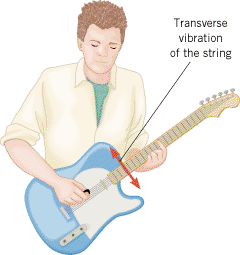Transverse waves travel on the strings of an electric guitar after the strings are plucked (see Figure 16.9). The length of each string between its two fixed ends is 0.628 m, and the mass is 0.208 g for the highest pitched E string and 3.32 g for the lowest pitched E string. Each string is under a tension of 226 N. Find the speeds of the waves on the two strings.
 |
|
Reasoning The speed of a wave on a guitar string, as expressed by Equation 16.2, depends on the tension F in the string and its linear density m/L. Since the tension is the same for both strings, and smaller linear densities give rise to greater speeds, we expect the wave speed to be greatest on the string with the smallest linear density.
Solution The speeds of the waves are given by Equation 16.2 as
 |